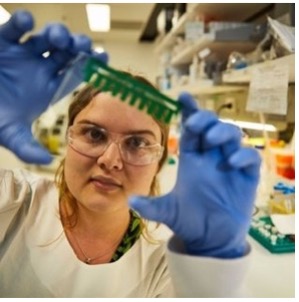RIN ECR
Dr Laura Leighton
I am a postdoc in Dr Tim Bredy’s lab at QBI with broad interest in RNA biology, and a particular focus on small noncoding RNAs and epitranscriptomics. I am currently working on small nucleolar RNAs and investigating the function of ‘orphan’ snoRNAs with non-canonical targets which are involved in regulation of learning and memory. I also love the breadth of creative methods that are emerging in the RNA space and am working on adapting techniques for examining RNA modifications and structure for the challenging sample types typical of neuroscience research.
Current funding
UQ postdoctoral fellowship
Seed grant from the Prader Willi Research Foundation of Australia.
Dr Rebecca San Gil

Rebecca is a postdoctoral fellow in Dr Adam Walker’s lab at QBI investigating the dysfunction of the RNA-binding protein, TDP-43, in motor neuron disease (MND) and frontotemporal dementia (FTD). My research investigates the transcriptome and proteome in cell and animal models of these diseases to advance our understanding of the biological processes that drive MND and FTD. In addition, I have applied genome-wide single guide RNA libraries for the CRISPR/Cas9 knockout of individual genes in pooled functional genomics screens to identify genes mediating TDP-43 dysfunction in disease.
Dr Min Chen
I work with Professor Reutens on miRNA profiling in the post-traumatic epilepsy model. We have observed that microRNAs change following immunomodulatory treatment and that improved functional outcome in a mouse model of TBI overlaps with microRNA expression in exosomes. We are interested in exploring the potential of modulating the inflammatory response using miRNA-bioengineered exosomes to reduce brain damage, improve recovery of motor and cognitive functions, and modify or prevent susceptibility to post-traumatic epilepsy.
Dr Xiaoying Cui

I have shown the long non-coding RNA (lncRNA) HOX-antisense intergenic RNA myeloid 1 (HOTAIRM1) is involved in the development of dopaminergic (DA) neurons. HOTARIM1 knockdown in the ventral midbrain of E11 mouse embryos reduces the expression of DA neuron specification factors while non-DA neurons appear to be spared. The histone methyltransferase EZH2 may be involved. My recent research focuses on how RNA methylation mediates dopamine-related behaviour in an animal model of schizophrenia. I have shown that enhanced dopamine synthesis promotes RNA methylation in the striatum. My future study will determine whether RNA methylation is the critical mechanism mediating the behavioural phenotype relevant to schizophrenia.
Dr Wei-Siang Liau

My research aimed at elucidating the function and activity of long non-coding RNAs at the synapse. I am particularly interested in how the activity of long non-coding RNAs and RNA modifications regulate the formation and maintenance of fear extinction memory. In addition, I am also interested in how small peptides derived from long non-coding RNAs affect synaptic plasticity and memory.
Dr Belal Shohayeb

I am a Post doc in Prof. Helen Cooper’s lab at QBI where I investigate synaptic plasticity, the cellular basis of learning and memory. The neuronal activity followed by long-term potentiation results in structural and compositional changes in excitatory synapses. This includes actin polymerization and protein synthesis which are tightly coupled. These processes are mediated by changes in the composition of protein complexes on the spine head and the release of mRNA for translation. We study how these processes are regulated and what are potential targets on the spines that may alter actin polymerization and mRNA translation/protein synthesis.
Dr Adekunle Bademosi

Adekunle is a postdoctoral fellow of Race Against Dementia – Dementia Australia Research Foundation at the Walker Lab. He uses advanced single-molecule imaging techniques to study the normal and pathological role of the RNA binding protein - TDP-43 in Motor neuron disease and Frontotemporal Dementia. He aims to shed light on the precise mechanisms involved in TDP-43 aggregation and how this might be stopped or reversed at nanoscale resolution. Further, he aims to characterise how altered RNA binding might alter the overall dynamics of TDP-43 in disease.
